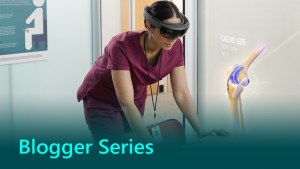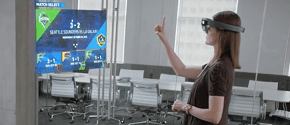
4 reasons why every business needs a mixed reality strategy
Computing has fundamentally changed how organisations operate. First it was access to simple computers and word processors. Then, the internet and smartphones bought instant access to many for a few hundred pounds. This era also gave rise to things like location-based services that started us down the path of contextual awareness and insight.
But, now, we are entering the third wave of computing. From construction sites to factory floors, from operating rooms to classrooms; mixed reality, AI, the intelligent edge and intelligent cloud are changing how we work, learn, communicate and get things done.
We are at the dawn of a new age of computing. One in which the digital world goes beyond two-dimensional screens and enters our three-dimensional world, empowering people to achieve more, in ways we could only have imagined until now. And it all started with mixed reality, such as the HoloLens 2. When you can have native 3D, have data in context at your fingertips, and be heads-up and hands-free in your projects, you can get massive gains.
And it all started with mixed reality, such as the Microsoft HoloLens back in 2016 which was the world’s first untethered holographic computer that you could wear. Since 2016, we have had 87 percent of enterprises evaluating, piloting, and beginning to deploy. The findings are that when you can have native 3D, have data in context at your fingertips, and be heads-up and hands-free in your projects – you can get massive gains.
But with the announcement of HoloLens 2, we continue to set the high watermark for mixed reality and AI in the edge of computing. And over the last 3 years, we’ve been hearing consistent feedback from you. You want greater immersion, greater comfort, and quicker time to value. With HoloLens 2, this is exactly what we’ve been focusing on.
Here are four reasons why your business needs a mixed reality strategy:
1. Empowering and protecting frontline workers
One of the most fundamental learnings that we’ve had with our customers over the last three years, is that this type of technology is empowering the frontline workers, who have often not had the same technology benefits as what the knowledge workers have benefitted from. Yet these workers are critical for organisations as they are the ones who are the closest to products and customers.
HoloLens is keeping essential healthcare workers safe, while significantly improving communications to help patients. Staff at Imperial College Healthcare NHS Trust are wearing the mixed-reality headset as they work on the frontline in the most high-risk area of some of London’s busiest hospitals. Using Remote Assist, doctors wearing HoloLens can hold hands-free Teams video calls with colleagues and experts anywhere in the world. They can receive advice, interacting with the caller and the patient at the same time, while medical notes and X-rays can also be placed alongside the call in the wearer’s field of view.
In construction, productivity in frontline workers has only grown 1 percent over the last two decades, which, when compared to knowledge workers who have benefitted greatly from technology is not a lot. Mixed reality lets these frontline workers access data and information on site, hands free, as they are working. This means they work quicker, make less mistakes, and stay connected to others.

In fact, according to the 2017 Forrester Consulting report, ‘Mixed Reality Unlocks New Ways for Organizations to Collaborate, Innovate, and Learn’ using mixed reality can boost productivity by 25 percent, while reducing errors to almost zero.
2. Improved training
We forget about 80 percent of what we learn after 30 days. This means we have to think about how we upskill and retrain our employees. By using mixed reality, you can provide hands-on visual learning at the touch of a button. Dynamics 365 Guides brings training to life with interactive content, photos, videos and 3D models bringing training. You can even use data to improve these experiences.
Plus, HoloLens can bring up manuals and guides while employees are working, offering a richer learning experience whenever they need it. It also provides training for situations that are hard to replicate in real-life, without real-life consequences such as machine breakdowns, construction issues, and even surgery.
CBRE is the world’s largest integrated real estate and facilities management company, serving major clients all around the globe. During a number of pilot projects on client sites, CBRE has seen the benefits of using mixed reality in remote collaboration for assisting their engineers and technicians to improve efficiency, collaboration and customer experiences. They also plan on using the HoloLens for training to create a more immersive learning experience, reduce travel costs and get employees up to speed faster, ensuring greater engineer confidence and better break-to-fix times for clients’ equipment and technical infrastructure to ensure maximum facility and asset uptime.
3. Remote servicing and collaboration
For some industries, technicians often travel all over to provide servicing, auditing, and maintenance on equipment. This can get costly and be time-consuming.
This is where a HoloLens with Dynamics 365 Remote Assist comes in. Your experts get a real-time view of a problem to troubleshoot efficiently. Not only does it reduce costs, but frontline workers will get training on how to solve the problem if it occurs again in the future. This type of instant collaboration is great way to solve problems quicker, while learning on the job.
At CBRE, an automation specialist on a life sciences account was asked to visit another of client’s site to carry out a repair and complete an application upgrade on some equipment. Unable to leave their current site, they were able to leverage the use of mixed reality to provide assistance.
“By using the HoloLens and the Remote Assist app, I was able to talk the engineers through the procedure whilst being able to see what they were doing,” they said. “This saved me valuable time and also provided training to the other engineers who carried out the work. It also saved possible call-out charges from the third-party vendor.”
4. Efficiency and quality gains
The best part of the HoloLens 2 is that it’s easy to use and comfortable, which means that your employees are more likely to reach out for it when they need to. It even fits over glasses. It adapts easily to the individual’s hand gestures, tracks eyes in real time, and is secure with Windows Hello. And with a range of apps already on the market, you can get up and running quicker than ever.

A 2018 Harvard Business Review report ‘A New Dimension of Work’ found that mixed reality improved field service and maintenance by four times. 80 percent of companies also reported it improved collaboration. Employees will be more engaged, productive, and knowledgeable.
Employee engagement has not just retaining benefits, but you’ll open yourself up to a wider talent pool. You’ll attract new labour and younger employees, while ensuring they can get to work quicker because they’re given the tools that they need to more easily learn.
From hospital wards to classrooms, construction sites to factory floors, mixed reality, AI, the intelligent edge and intelligent cloud are changing the way we work, learn, communicate, and get things done.
Mixed reality brings to life everything we need to contextualise work. This makes for fewer errors, faster and more productive employees, better training, improved employee safety and amazing collaboration abilities.
Find out more
Read the blog – What is mixed reality and is it right for your business?
Download the eBook – Mixed reality: Why nine out of ten businesses plan to use it
Explore the product – HoloLens 2
About the author
 Leila has been working on the commercial mixed reality business for the last four years and is based in the UK. She’s been working with some of the most advanced customers and partners in the world, helping them identify, pilot and deploy technologies that have a profound ability to transform their business.
Leila has been working on the commercial mixed reality business for the last four years and is based in the UK. She’s been working with some of the most advanced customers and partners in the world, helping them identify, pilot and deploy technologies that have a profound ability to transform their business.
Prior to joining the mixed reality team, she held several senior positions at Microsoft including leading consumer and commercial business units such as Server & Tools and Windows in the UK and Central & Eastern Europe





